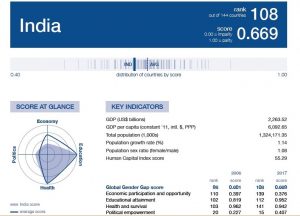Recently global gender gap index, declared by world economic forum (WEF), has been in the news, for reporting reverse shift of gender parity globally this year, since it was first introduced, in the year 2006.
Interestingly WEF report also reiterates, while discussing on participation of women in Industrial level, what we already know. It clearly states that though more qualified women are coming out of education system, Industries are failing to hire, retain and promote them, losing on wealth of capacities. Women constitutes a half of the world’s talent pool. As world moves what the report calls, towards talentism, competitiveness is determined more and more by innovation capacity of an industry or a country. In such a context, integration of women talent is an absolute must!
The Report benchmarks 144 countries on their progress towards gender parity on a scale from 0 (imparity) to 1 (parity) across four thematic dimensions—Economic Participation and Opportunity, Educational Attainment, Health and Survival, and Political Empowerment— and provides country rankings that allow for effective comparisons across regions and income groups.
In 2017, the gap in economic and political participation is actually seeing a reverse progress, worldwide, which is of course not a good omen for women empowerment.
Out of 144 countries, India’s rank is 108, which is a substantial notches down not only from the last year’s spot, but also from the rank it held initially in 2006. Also, fact remains that of the four metrics, lowest percentage contribution is of economic participation and opportunity, with a score of 0.376 in a scale of 0 to 1, rank being 139. The overall rank for India could have been much lower, but for the political empowerment scale, where although score is low but with a low world average, India has managed to maintain its top twenty ranks, as always.

Various studies by the group and World Bank also, suggests that increasing gender parity, improves the country’s GDP by a significant amount. Participation of women in workforce, increases the spending capacities, and in turn the women executives in company helps more in understanding a diverse customer base, thus, closing the cycle of need for women professionals.
This report says that in case of, senior officials and managers, professional and technical workers, India needs to make continuous efforts to improve gender parity, in order to improve rank on economic participation and opportunity!
Economic Participation – Energy Sector:
In a 2016 study, WEF ranked Energy Sector to be among the bottom three economic sectors in female participation. Research reveals only a small proportion of female executives at board level, and there are only a handful of women CEOs serving at energy companies in the S&P 500.
WEF in partnership with LinkedIn, also publishes a data on industry wise hiring of women workforce at entry level as well as senior level, where it is seen that sectors like Manufacturing and Energy still performs poorly, whereas industries like IT has caught up really well from a low base. These studies identify unconscious biases and scarcity of systemic efforts towards driving change at the industry level as well as country level, to be the major causes of poor gender parity in an Industry like Energy.
Since, the relation between women’s participation in economy and the improved economic performance for the country, has been well established, it should be a natural conclusion for both country and industry to make efforts to reduce gender gap in industries like energy industry, in a systemic way.
There have been public private partnership model successfully tested in countries to accelerate the progress by bringing more women into the economy. It is important for an industry to facilitate both entry level participation and senior level presence for women, to bring an uniform parity, which would help not only balancing the talent pool, but also bring more stable and healthy performance by the industry.
Ensuring healthy development and appropriate use of half the talent pool, would help Energy industry to have a vast bearing on the growth, competitiveness and future readiness of business.
Source: World economic Forum report
Full report available at http://www3.weforum.org/docs/WEF_GGGR_2017.pdf
